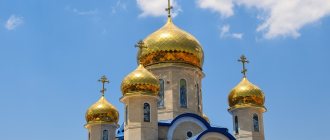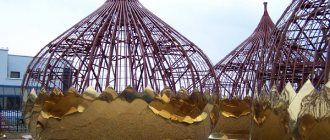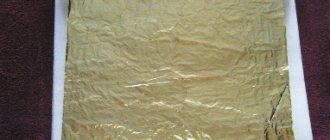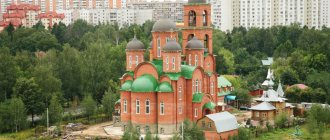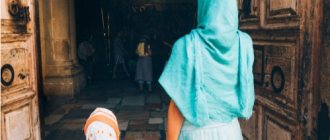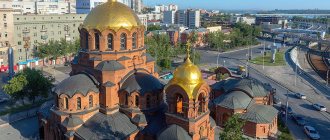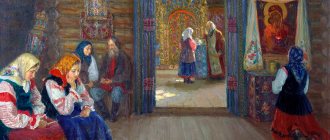And why domes?
Because it is the shape of the dome that personifies the desire of Christians for eternal good life. The sphere is heaven, the closed circle is eternity, which has neither beginning nor end. And, of course, the desire to go up, to heaven and the cross that crowns everything.
Most churches in Russia have golden domes, but you can also find buildings with blue, green and black domes, and, interestingly, they are not always the same color. There are domes where golden stars are depicted on an azure (blue) background.
The dome was inherited by Christianity from the Roman Empire
Domes are much older than Islam and Christianity. Archaeologists discovered domes during excavations on the island of Cyprus. These products date back to the fifth century BC.
There were still Wonders of the World in the world that had not survived to this day, and an architectural tradition that would be relevant to this day already existed.
It is noteworthy that the dome is older than the arch, although it looks like a more complex product.
But the complexity of the oldest domes should not be overestimated.
These were primitive designs, and temple heads similar to today’s were invented in ancient Rome.
Around the time when concrete began to be widely used.
The Pantheon temple has the oldest dome; there was once a Christian church here
The real year of birth of the domes can be considered the year 128 - when it was used in the construction of the rotunda of the Pantheon temple. By the way, yes, all the gods were worshiped there. That's where the word came from.
In 609, Emperor Phocas donated the temple to the Pope.
It was turned into the Church of St. Mary and the Martyrs. The illumination took place on May 13, and then they began to celebrate All Saints' Day. Only a couple of thousand years later the date was shifted to November 1. This is how the pagan holiday influenced the dating of the Catholic one.
And Christianity inherited from Rome not only temples, but also the tradition of using domes. Later they were adopted by the Muslim world, and now domes are present on mosques and mausoleums. And even later, the dome became part of Russian architecture.
The number of domes on temples ranges from one to thirty-three
The number of domes on Orthodox churches also matters. But the scale of the temple and the financial capabilities of the parish also play a significant role here. You shouldn't forget about this.
Church of the Transfiguration, Fr. Kizhi, 22 domes
But let's talk about the symbolic meaning: how many domes mean what in the Orthodox tradition:
The one-domed temple symbolizes the One God.
The two domes symbolize the human and divine nature of the Savior. They are very rare. An example is the Church of Cosmas and Damian in Stare Paneh.
Temple of Cosmas and Damian in Stare Paneh. A rare case when a temple has two domes
Three domes are a reminder of the Holy Trinity.
The five domes are the four Evangelists and Jesus Christ.
Assumption Cathedral with 5 domes. Moscow
The seven domes symbolize the sacraments of the Orthodox Church.
The nine domes symbolize the nine ranks of angels (from the highest seraphim to the lowest - angels).
Thirteen domes symbolize Jesus Christ and his twelve disciples.
Twenty-two domes are quite difficult to compare with anything. 22 letters in the Hebrew alphabet. Bible verse 22 writes about Eve. 22 chapters in the book of Revelation.
It is difficult to identify the 22 domes with anything in Christian symbolism.
The twenty-five domes on the church represent the glorification of the Mother of God by the twenty-five prophets of the Old Testament. It is also a heavenly throne surrounded by twenty-four elders (an image from the apocalypse).
Intercession Church of the Intercession of the Blessed Virgin Mary in the Vsevolzhsky district of the Leningrad region. Has 25 domes
Thirty-three domes remind us of the years the Savior lived.
Transfiguration Church with 33 domes in the Volgograd region. The number of domes corresponds to the number of earthly years of Jesus Christ
So that the Lord notices more often. What does the shape of the domes of Yaroslavl churches mean?
The Bright Resurrection of Christ is ahead! The church service on Easter is especially solemn, since it marks the main event of the year for Christians.
Time for joy.
Festive services for Easter will be held in all operating churches of the Yaroslavl Metropolitanate. Coming to Easter services on the day of the Resurrection of Christ and celebrating the celebration of Easter in the church is a must for an Orthodox believer.
Everyone makes their own choice of which temple to visit - a small, almost domestic church or one that is filled with solemnity and majesty of decoration. But, probably, everyone’s spirit is taken away when you look into the sky – at the domes! What kind of meaning do believers put into the shape, color and number of domes of the Orthodox Church? We decided to look into the portal “Culture.RF” using the example of churches in the Yaroslavl, Rybinsk and Pereslavl dioceses. Even in our atheistic childhood, we firmly learned, thanks to Vladimir Semenovich Vysotsky, that “Domes in Russia are covered with pure gold so that God will notice more often.” However, in reality, Orthodox architecture offers many options.
From gold to black
Green. This color is considered a sign of the Holy Spirit. Most often it can be found on churches dedicated to the Holy Trinity, for example, green domes on the Trinity Church in Poshekhonye. Similar domes crown churches built in honor of Orthodox saints. For example, the Church of Elijah the Prophet in Yaroslavl - one of the key monuments of the local school of the 17th century - or the Church of St. Andrew Stratilates in the village of Sulost, Rostov region.
Gold is indeed the most common color of Orthodox domes. He personifies eternity and heavenly glory. Temples with golden domes were usually dedicated to Christ and the great church holidays - Christmas, Candlemas, and the Annunciation. Such chapters crown the new Assumption Cathedral, the Transfiguration Cathedral on the territory of the State Historical, Architectural and Art Museum-Reserve in Yaroslavl. Of course, today domes of this type are not literally lined with gold, but in the past the noble metal was actually dissolved in mercury, and then the resulting amalgam was applied to a hot copper sheet. The gilding process was very expensive and labor intensive. For example, it took 100 kilograms of gold to cover the dome of St. Isaac's Cathedral.
Black. Domes of this color are rare and usually decorate monastery churches, but not only them. Black domes crown, for example, the wooden church of the icon of the Mother of God “Seeking the Lost” and “Joy of All Who Sorrow” at the Churilkovskoye cemetery in Yaroslavl.
Silver. This color in Orthodoxy is associated with purity and holiness. Temples dedicated to various saints are crowned with silver domes, for example, the Church of St. Nicholas the Wonderworker in the village of Nikolskoye, Nekrasovsky district, the Church of Elijah the Prophet in the village of Moseytsevo, Rostov region, the Church of St. Michael the Archangel “in Bor” in the village of Arkhangelskoye near Uglich. But a silver dome can also crown churches dedicated to icons of the Mother of God, for example, the Kazan Cathedral in Danilov.
Multicolored domes in the Orthodox tradition remind believers of the beauty of Heavenly Jerusalem. This is what the heads of the Church of the Savior on Spilled Blood in St. Petersburg and St. Basil's Cathedral in Moscow look like. Foreign travelers admired the colorful patterns of the domes and compared them with the scales of a pine cone, pineapple and artichoke. The domes acquired this appearance after the fire of 1595 - then the temple was restored and rebuilt. And in our area, multi-colored domes decorate the Church of the Resurrection of the Word in the village of Lakhost near Gavrilov-Yam.
Blue with stars, blue or light blue. Temples with such domes are most often dedicated to the Virgin Mary. The blue color symbolizes the purity and purity of the Virgin Mary, and the stars refer to the Star of Bethlehem, which marked the Nativity of Jesus Christ. The Church of the Dormition of the Blessed Virgin Mary in the village of Vepreva Pustyn, Rostov region, is crowned with such domes. Simply blue domes crown the Vvedensky Church in the village of Zarnitsino, Fominsky rural district, Konstantinovsky rural settlement, Tutaevsky district, and the Annunciation Church in the village of Dyudkovo, Rybinsk district. But there are also cathedrals with blue domes that are not associated with the name of the Virgin Mary. For example, the Church of St. Leonty of Rostov in Yaroslavl.
Not just bulbs
The spherical dome in the Orthodox tradition symbolizes eternity. The Romans began building churches with similar domes: in the 2nd century they learned to build large-area ceilings without supports. The Roman pantheon built in this way from 128 AD has survived to this day. In Russia, spherical domes crown Moscow's Elokhov Cathedral, the baptismal site of Alexander Pushkin. And in Yaroslavl there is the Ilinsko-Tikhonovsky Church on the Volzhskaya Embankment and the Intercession Church in the courtyard of the Kazan Monastery, a former planetarium.
The helmet-shaped dome refers to the words of the Apostle Paul: “Put on the whole armor of God... and take the helmet of salvation, and the sword of the Spirit, which is the Word of God.” Such domes are typical of Russian pre-Mongol architecture: they decorate, for example, the Assumption Cathedral in Vladimir and the Church of Peter and Paul in Smolensk. But there are also such in Yaroslavl - for example, the domes of the restored Transfiguration Cathedral on the territory of the museum-reserve.
The onion dome in Orthodox architecture is the embodiment of prayer, the desire for heaven. According to researcher Evgeny Trubetskoy, such a dome on the base of the drum resembles a candle flame. Onion-shaped domes are characteristic of Russian architecture of the 16th – 17th centuries. Examples of churches with similar domes in our area are the Church of the Nativity of John the Baptist in Uglich and the churches of the Rostov Kremlin.
A tent, instead of a traditional dome, is interpreted in Christianity as an image of the Virgin Mary or the Light of Heaven. Tent churches were common in the 16th century, although similar churches were built earlier. They were usually built from wood: it was very difficult to replicate the structure of a tent in stone. The most famous example of tent architecture is the Church of the Ascension in Kolomenskoye. In the Yaroslavl region, a striking example of a tented church is the Church of Metropolitan Peter in Pereslavl.
From 1 to 33
One dome reminds believers of the unity of God. Single-domed temples were especially popular in pre-Mongol times. The most famous of them are the Church of the Intercession on the Nerl and St. Demetrius Cathedral in Vladimir. Both temples were built in the 12th century - they survived the devastating Mongol-Tatar invasions and have survived to this day. On Yaroslavl land, the only remaining monument of pre-Mongol architecture is the single-domed, four-pillar, three-apse, white-stone Spaso-Preobrazhensky Cathedral in Pereslavl, where the holy noble prince Alexander Nevsky was baptized.
The two domes are rare and commemorate the divine and human nature of Jesus Christ. The three domes are associated with the Holy Trinity. A typical example is the Church of the Beheading of John the Baptist with a belfry in the St. Nicholas Convent of Pereslavl-Zalessky. The five domes are a symbol of Jesus Christ and the four evangelists: John, Mark, Luke and Matthew. Five-domed churches are more common in Russia than others. The most famous of them are the Assumption Cathedral in Vladimir and the Assumption Cathedral in the Moscow Kremlin, built in its image. An example from our region is the Church of the Holy Martyrs Florus and Laurus in Uglich.
The seven domes represent for the Orthodox the seven sacraments of the Church, the seven Ecumenical Councils (meetings at which the basic Christian dogmas were adopted) and the seven cardinal Orthodox virtues. The nine domes are associated with the nine ranks of angels. Thirteen domes are reminiscent of Jesus Christ and his companions - the twelve apostles. Twenty-five domes mean praise to the Most Holy Theotokos - the glorification of the Most Pure Virgin by 25 Old Testament prophets. In addition, the number 25 symbolizes the vision of the heavenly throne and the 24 elders surrounding it, described in the Revelation of John the Theologian. Thirty-three domes symbolize the years of Christ's life on earth. Such temples were built very rarely. The Church of the Beheading of John the Baptist in Yaroslavl has fifteen domes, but this is rather an exception to the rule.
The color of the dome can have a symbolic meaning, but not necessarily
Domes and temples are found in different colors. It makes sense. But it’s not always worth looking for it. If we are talking about a poor one-story church, the dome of which was painted with what was found in the garage so as not to rust, then it is unlikely that there is any sacred meaning here.
No one obliges individual parishes to determine the color of a church or dome according to any set of rules. Often people don’t even think about such things, because in church life they are not secondary or even tertiary.
But you can still put meaning into the color of the dome. Color matches are highlighted. The color of the dome indicates who it is dedicated to:
- a temple with white domes - clarity, transparency, this is a temple consecrated in honor of the Transfiguration, or the Ascension of the Lord;
Church of the Ascension of the Lord. Village Karinka
- a temple with blue domes (also with blue domes) is chastity, most often the Blessed Virgin Mary is meant;
Church of the Nativity of the Blessed Virgin Mary in Vladikavkaz
- a church with green domes is dedicated to a certain saint. Green domes are a sign of renewal. Also, the domes on the church are painted green in honor of the Holy Spirit, or all the Holy Trinity;
The Holy Trinity Cathedral in Krasnodar has green domes - the color of the Holy Spirit
- yellow - in honor of the saint;
Church of St. Nicholas the Wonderworker in Magnitogorsk
- red - a temple in memory of the martyr. For the temple, the red color obviously expresses human sacrifice, reminiscent of blood. But a red dome is rare, even if the church is in honor of a martyr;
The Church of St. Panteleimon has red domes.
Red domes are very rare.
- blue domes with stars - reminiscent of the story of the birth of Jesus Christ;
Trinity-Sergius Lavra
- silver domes on the church are a sign that it has a patron saint, like those churches that have green domes;
Church of St. Nicholas on Lipna near Veliky Novgorod
- The multi-colored dome is reminiscent of the heavenly Jerusalem. St. Basil's Cathedral in Moscow, perhaps the main church in the country, has such chapters;
St. Basil's Cathedral in Moscow
- The black domes on the church evoke frightening associations in people. But you shouldn't draw premature conclusions. Satanism has nothing to do with it. Black is the color of monasticism.
You can usually find similar buildings in monasteries. But not only in them. One of the churches with black domes was ordered by Alexander III when he escaped from a train crash. With him he had an icon of the Savior Not Made by Hands. The Emperor ordered the reconstruction of the Temple of the All-Merciful Savior (Nizhny Novgorod). This church has black domes.
Temple of the All-Merciful Savior (Nizhny Novgorod)
Golden domes are not a sign of luxury, but a tribute to tradition
There are two reasons why domes are often painted green: symbolic and practical (more precisely, traditional):
- Symbolic. Gold reminds of power, of reign. That is, about the King of Heaven. This is the metal of glory, and therefore it is ideally suited for decorating churches in honor of the Savior. It is very popular because the desire to pay homage to Jesus Christ often becomes the determining factor when choosing a color.
- Practical. This side is no longer relevant and remains a tribute to tradition. But it still needs to be mentioned. Previously, high-quality roofing iron could not be invented in Rus'. It was necessary to have good knowledge of chemistry, but there was not enough of that. Weather conditions destroyed many metals. But gold is an exception. It does not oxidize, so if you cover the dome with the thinnest gold coating, the problem with weather conditions will be immediately solved.
Of course, this is not the only example. Domes could be made from other metals that do not oxidize. But the choice fell on the one that was not only more practical, but also more beautiful.
Today there are enough materials, so it is customary to paint domes gold. Real gold to cover the dome is a waste. A metal that is often mistaken for gold is titanium nitride.
How much does the dome weigh?
Typically the weight of the dome is about 15 kg. Modern parachutes can provide a soft landing for paratroopers weighing up to 160 kg. Previously, this figure did not exceed 120 kg.
Interesting materials:
How to get documents into my documents? How to view recently opened documents in Excel? How can I view the latest documents? How to view the latest open documents in Word? How to digitally sign a PDF document? How to properly send documents by email? How to fill out the list of documents correctly? How to properly certify a copy of a double-sided document? How to provide documents to the tax office upon request? How to convert a presentation to a Word document?
The shape of the dome can also have a symbolic meaning: from a candle to the heavenly host
The dome is also intended to evoke certain associations.
The helmet-shaped dome is an image of the spiritual army, a message to a person that the church is fighting for the salvation of his soul.
Spherical domes are a symbol of eternity.
The onion-shaped dome is a candle flame. Reminds me of the phrase of Jesus Christ: “You are the light of the world.” Calls for prayer, indicates that we need to strive for heaven.
The tent-shaped dome is a heavenly light, the image of the Virgin Mary.
The complex shapes of the domes convey how beautiful Heavenly Jerusalem is.
The complex shape of the dome of the Church of the Sign of the Blessed Virgin Mary in the village of Dubovitsy
The cross on the dome reminds people of salvation; it can be complemented by a crescent
The cross on the domes of churches sometimes looks unusual, and then questions arise.
Why is there a cross on the temple at all? He reports on the main idea of Orthodoxy - the salvation of the soul of a Christian believer. The cross rises on the church, like a saving sail on a ship. This symbol is addressed to the believer so that he does not forget the main purpose of the church.
What kind of crescent is on the cross? Of course, it has nothing to do with Islam. There are simply versions that the cross in this position seems to dominate the Islamic symbol. No, this is not so and has nothing to do with it at all. This image is called “tsata”.
The crescent moon on the cross comes from the book of Revelation.
This is a symbol of royal power. It has been known since Byzantine times. Tsata is found not only on crosses, but also on icons. Very often it decorates images of St. Nicholas the Wonderworker.
There are quotes on other icons:
- Holy Trinity;
- Jesus Christ;
- Mother of God.
The tsat is worth seeing as a symbol of power—but spiritual power. She reminds believers that the head of the Church is Jesus Christ. This is important so that people do not forget that the church is not only an earthly organization with its own hierarchy, but something more, spiritual.
But you can trace the image of tsata even deeper - find its prototype in the Holy Scriptures. The Apostle John the Theologian describes one of his visions in the book of Revelation:
“And a great sign appeared in heaven: a woman clothed with the sun, with the moon under her feet, and on her head a crown of 12 stars.”
John the Theologian
apostle
Deciphering the book of John the Theologian is not even the subject of a separate article, but, perhaps, an entire science. But you still can’t miss the most obvious correspondences:
- twelve tribes of Israel;
- twelve apostles.
And now there are twelve stars and the moon under the woman’s feet. Isn’t this very woman the Church of Christ? Or maybe the soul of every person? It is possible that the apostle introduced a multi-level meaning and implied all interpretations at once.
But this passage is important because it is precisely such a cross, with a crescent and stars, that crowns the domes of many Orthodox churches. For example, the Holy Trinity Cathedral of Verkhoturye.
The crescent moon and twelve stars on the domes of the temple refer to symbols from the book of Revelation
There are other explanations for the crescent moon, but this seems the most convincing.
By leaving a comment, you accept the user agreement
Why do churches need domes?
The domes of Orthodox churches as we know them now are purely a matter of tradition. In the sense that this is how it happened: churches should have domes. Moreover, it worked out exactly for us. In Orthodox Greece, for example, many churches are built without the usual domes.
Here, for example, is a church on the island of Corfu: typical Orthodox Greek architecture.
Like this temple: also Greece
Then what do domes actually mean for a temple if they are not built everywhere, and why does the temple need them?
Initially, a dome is just one type of vault that a building can have. For example, this design would be ideal to enclose large spaces when supporting columns need to be avoided. This type of overlap has been known since ancient times. Even before Christianity, domes were erected in buildings of worship and importance for the state - in short, where a large number of people gathered to celebrate something or perform a religious ceremony.
Over time, domes began to be directly associated with “sacred” buildings. In the Christian tradition, the domed vault immediately began to symbolize the heavenly world, eternity, and the universe. Moreover, symbolism almost immediately became the main side of the dome, since in most temples (in those countries and cultures where it was used) the dome did not and does not have a constructive meaning and was simply the “crowning” of the structure.
Look: Hagia Sophia in Constantinople (now a mosque). It was built as an Orthodox church in the 6th century, but retained the “original” approach to the dome - as a full-fledged vault.
And here is the temple in Barashi, Moscow. The dome is small, “symbolic”. The role of the vault is played by the roof-slab.
The fact that the dome can play a “symbolic” rather than constructive role has developed historically. For example, in Rus': the first churches themselves were almost all wooden and were made using the classic log house technique, so covering them with large domes was structurally illogical and impractical. The dome no longer played the role of a “roof”, but simply rose above the temple. Therefore, it is more correct to call them not domes, but chapters or “domes.”
This is not an ancient temple, but a modern one: in the village of Verbilki near Moscow, but it well illustrates what has been said about the domes of wooden churches:
And here is an example of a temple design where the dome, on the contrary, actually plays a constructive role. Moscow. Church of the Assumption of the Blessed Virgin Mary near Prechistenka. The dome covers the entire chapel, although there is still a small turret above it, which is crowned with an “onion”.
Or the Church of St. Michael the Archangel in Kubinka near Moscow. Also: a large dome-shaped vault and a smaller “onion” above it.
Or the main cathedral of the St. John the Baptist Monastery in Moscow. Not the most clearly expressed example, perhaps, but nevertheless:
Domes have truly become an integral part of Russian tradition. Moreover, our domes are characterized by the “onion” shape. Some see this as a reminder of a burning candle. Maybe. But initially, such symbolism was not included in the onion-like shape of the dome - it was simply about a beautiful form that would harmoniously complete the image of the temple.
Moscow Compound of the Holy Trinity Sergius Lavra in Moscow
